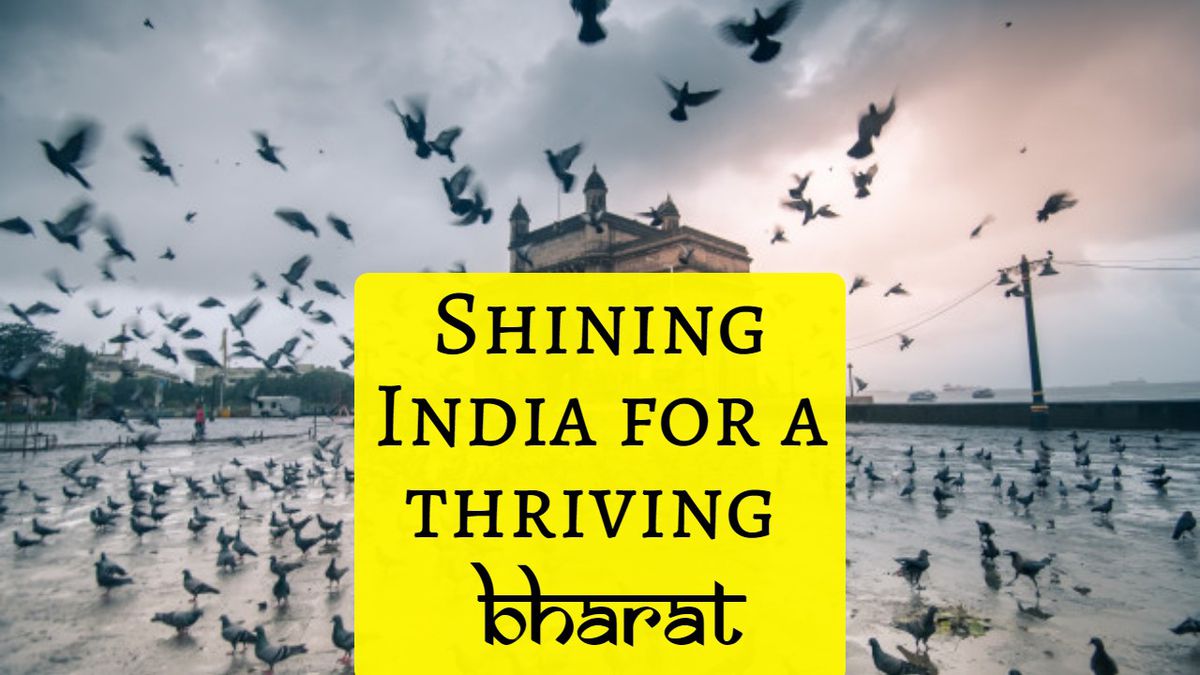
The massive reverse migration that we witnessed while cities underwent lockdown is being seen as an unprecedented opportunity to push the rural economy. With fair prudence one can say that a push to rural economy bodes well for our country because of two reasons that stand out- It serves an enormous rural population that constitutes 66% of India and it’s a balancing act awaited for decades and releases pressure from our cities’ ecosystem. The reverse migration also underscores the fact that the Gangetic belt of UP Bihar remains the perpetually large source of manpower for all weather needs of our cities. The cities meanwhile are struggling to maintain their growth tempo even after the lockdown have been lifted. The physical infrastructure of our mega polis look lack luster and insipid today during the unlocking process, and the works in progress towards the ‘place making’ are failing to come out of this inertia. On the other hand, the rural economy is looking smug with good monsoon and a newly generated demand stashed out from the cities. A fair amount of moral validation has also been attributed to the rural India or “Bharat” for feeding the cities well during the lockdowns. So where are we headed now in post lockdown times. Are cities and their agglomerates going to lose out on some sheen in terms of socio-economic landscape and some re balancing stays firmly on cards?
The discourse on Urbanization in our country have got a few new drivers asunder the classic ones like being the engine of economy, the seat of innovators, the hub of scientific intellect, action, opportunities and vanguards of our might. So the new drivers emerging from Covid times like, digital push, work from home policy in the companies, renewed emphasis on healthcare infrastructure and our homes along with a preference for private transport. All of these are bound to have a lasting impact on the form & tempo of urbanization. The Bharat is going to stay dynamic for now- a valid argument that is telling clearly on the rural India, with ample support from the Governments in the form of rural employment guarantee and food security along with a clarion call for attracting investment into agro-based industries.
So what do we make of this dynamism? Possibly, a greater push to urbanization in the biggest and densest of the rural strip, i.e. The Gangetic belt. Which also is our ‘Go to’ repository for migrant workers.
Consider the steepest population density in our country of generally 1000-2000 per sq km and a very large portion of this belt having density of above 2000 person per sq km. The entire stretch of Gangetic plains also known as comprising of entire UP, Bihar & Bengal boasts of, one of the most densely populated human settlement ever historically. Ironically the rate of Urbanization in all these three provinces serves you many compelling reasons to rethink and strategize our new patterns of human settlement. Except for West Bengal, as per 2011 census data, which almost matches the national level of urbanization at around 32 %, UP at 22.8% and Bihar shockingly at 11.3%. In Uttar Pradesh also the eastern part (Purvanchal) is much denser at the same time much less urbanized. The evident lack of urbanization in the Gangetic plains have many obvious symptoms like- lopsided dependence upon agrarian economy, underdeveloped civic infrastructure, deplorable human development index and employment opportunities. However apart from these the biggest sore point that this massive populace has been facing is an absolute loss of appetite for manufacturing entrepreneurship. The economic liberalization failed to wake up this appetite in this region, neither the turn of the millennium nor the advent of Modi government (not withstanding Mr. Modi’s profound understanding of this problem which he has demonstrated many times). The Gangetic belt is home to 35% of Indians with a share of about 20% in our overall GDP. And the per capita GDP below national average i.e. $1964, WB ($1600), UP ($972) and Bihar at a paltry ($ 640).
So when we talk about post lockdown dynamism in Bharat how does it augur for the Gangetic or Cow belt?
The big-ticket benefit that it stands to gain is return of skilled labour. That brings with us a glimmer of possibilities and loads of added responsibilities for these states. Certainly, the state governments have acknowledged this influx of skilled workers like in UP & Jharkhand for example, and they have got into some sort of planning around this scenario. The recent spate of changes made by the state governments in the labour laws is being seen as an effort to respond to this situation.
But can the manufacturing entrepreneurship and the required investment to fuel it up, can be invigorated quickly in this span of few months or may be a year of coronavirus spread? Well, no right thinking person can expect such drastic turn of events. Urbanization is as much a natural progression of human & economic settlement as a manifestation of their culture as well. The Gangetic belt finds itself in a transition from agrarian economy to traders and at the most to a service-based economy. Thousands of years of harvesting gold from super fertile land has a deep genetic character built in the culture of the people here. Which is probably attributed to all of the river side civilizations in the world history, something that is obviously making of thousands of the years. The real world of opportunity that got flourished during the 1990’s liberalization failed to create any renewed ripples of urbanization in the part of the country while the region was having a tryst with political volatility on the issue of Social justice. By the turn of the millennium and during much of 2000s also even while the issues of Social justice appeared little settled the whole region failed to attract investments for it’s cities.
Urbanization thrives when a certain set of conditions prevail, like, availability of skilled manpower both to produce and consume, low crime rates, political stability and continuity in state policies towards business, availability of sound infrastructure like cheap land, uninterrupted power supply, water, physical & digital connectivity, transport, quality of life, liveability and availability of finance for new ventures. On all these parameters the Gangetic belt has been failing over last 2-3 decades now. And you see a low level of urbanization all across this region necessarily as consequence. Despite the impetus to declare more & more ‘Census Towns’ in this region the tempo of urbanization remain centered around a few big cities like Ghaziabad, Lucknow, Kanpur, Prayagraj, Patna, Gaya & Muzaffarpur, i.e. the Class 1 cities. In Uttar Pradesh the class 1 cities attract about 55% of the total urban population which clearly indicates imbalances in Urbanization as well. The big keep getting bigger and agglomerate, as more opportunities for liveability get created in the class 1 cities. The Class V (upto 5000 Population) and class VI (5001 to 10,000) towns develop over the fringes of both rural and urban peripheries offering service, marketing and alternative opportunities to the Cities and villages alike. These small towns play a very important role in providing alternative opportunities to the villagers and city dwellers alike at the same time providing a tool to the governments for accessing remote areas. In both UP and Bihar there is an emphasis on declaring more & more ‘Census towns’ so definitely you may have a new wave of urbanization for the records. The quality part of this urbanization is an issue for another day.
The Covid for the first time has provided these small towns of Gangetic plains an opportunity to regain the sunken ground. With the presence of millions of skilled labour back there in the small towns and villages, for the first time, they are witnessing a renewed demand and less dependency over the big cities.
On the other hand, the question around big cities is coming up if they are going to regain and reclaim the lost bits. The likeliest answer is a firm Yes. The pain areas that come along with the largeness of the cities like Slums, poor municipal supervision, pollution or even crime, are adding to the clamor of voices against the power of these cities. The big cities evolved through the centuries of growth operate like a giant living organism agglomerating with many neighboring areas thus adding efficiency, competitiveness and keen resilience to survive. They develop unique abilities to go through cycles of crisis, war, famine, natural disasters, economic disasters, pandemics and many a times colossal political neglect. Globally cities are responsible for though the key argument here is - our big cities need to thrive for the sake of longevity of rural India, i.e. Bharat. A shining India is a key to a thriving Bharat. The relationship between the Urban and rural is quite interdependent yet we need to understand it in more detail. Jane Jacobs in her famous book, “the economy of cities”, propounded the theory of ‘Import replacement’ with which cities keep adding self-reliance to their portfolio by replacing import with their own production. The largest part of the road to “Aatm Nirbhar Bharat” shall go through the Urban India only, therefore.
Popular belief is Urban areas are sucking up resources like water, construction material like Sand from the rural. While it’s true to a large extent at the same time the factories of urban India are running round the clock to provide for your motor cycles, tractors, generator sets, pump sets, mobile phones, packaged food etc and above all the cities are running round the clock to serve as centers of aspiration. The entire Supply chains of many products that are hugely consumed in the rural India originate from our cities only, something that the villages and small-town dwellers look up to, for transforming their lives. Cities serve as Marketplace for farm produce, raw material, manpower and above all the aspirational youth of Bharat.
In the context of Gangetic belt again, the existence of Delhi-Mumbai is as much critical for their survival as the availability of Urea for their farms. Migration to the big cities from this region in search of a better life is deeply entrenched in the psyche of people for generations. The migrant workers coming from this region have their roots, kith & kins and assets here which are big beneficiaries of this relationship with the cities. Despite the exhibitionism of owning their skills by the governments, the momentary charm of MNREGA or food security, they will soon be back to the Cities as their relationship with the cities is just so much complimentary. And their return to the big cities is also likely to coincide with a parallel push to growth of many Class IV, V and VI towns in their region which stand as big beneficiaries of people’s movement across the country.
So, as a well-known economic potential of our Cities, like, the city of Mumbai having 2% of national population but boasting of a lion’s share of 6.3% of GDP, have always made it a land of opportunities & dreams for the Gangetic belt. The regional India needs the big wheels of our cities to churn faster to wipe its own poverty, innovation and uninterrupted supply chain.






 tag on profile.
tag on profile.
By Anand Prakash {{descmodel.currdesc.readstats }}
Anand Prakash {{descmodel.currdesc.readstats }}
The massive reverse migration that we witnessed while cities underwent lockdown is being seen as an unprecedented opportunity to push the rural economy. With fair prudence one can say that a push to rural economy bodes well for our country because of two reasons that stand out- It serves an enormous rural population that constitutes 66% of India and it’s a balancing act awaited for decades and releases pressure from our cities’ ecosystem. The reverse migration also underscores the fact that the Gangetic belt of UP Bihar remains the perpetually large source of manpower for all weather needs of our cities. The cities meanwhile are struggling to maintain their growth tempo even after the lockdown have been lifted. The physical infrastructure of our mega polis look lack luster and insipid today during the unlocking process, and the works in progress towards the ‘place making’ are failing to come out of this inertia. On the other hand, the rural economy is looking smug with good monsoon and a newly generated demand stashed out from the cities. A fair amount of moral validation has also been attributed to the rural India or “Bharat” for feeding the cities well during the lockdowns. So where are we headed now in post lockdown times. Are cities and their agglomerates going to lose out on some sheen in terms of socio-economic landscape and some re balancing stays firmly on cards?
The discourse on Urbanization in our country have got a few new drivers asunder the classic ones like being the engine of economy, the seat of innovators, the hub of scientific intellect, action, opportunities and vanguards of our might. So the new drivers emerging from Covid times like, digital push, work from home policy in the companies, renewed emphasis on healthcare infrastructure and our homes along with a preference for private transport. All of these are bound to have a lasting impact on the form & tempo of urbanization. The Bharat is going to stay dynamic for now- a valid argument that is telling clearly on the rural India, with ample support from the Governments in the form of rural employment guarantee and food security along with a clarion call for attracting investment into agro-based industries.
So what do we make of this dynamism? Possibly, a greater push to urbanization in the biggest and densest of the rural strip, i.e. The Gangetic belt. Which also is our ‘Go to’ repository for migrant workers.
Consider the steepest population density in our country of generally 1000-2000 per sq km and a very large portion of this belt having density of above 2000 person per sq km. The entire stretch of Gangetic plains also known as comprising of entire UP, Bihar & Bengal boasts of, one of the most densely populated human settlement ever historically. Ironically the rate of Urbanization in all these three provinces serves you many compelling reasons to rethink and strategize our new patterns of human settlement. Except for West Bengal, as per 2011 census data, which almost matches the national level of urbanization at around 32 %, UP at 22.8% and Bihar shockingly at 11.3%. In Uttar Pradesh also the eastern part (Purvanchal) is much denser at the same time much less urbanized. The evident lack of urbanization in the Gangetic plains have many obvious symptoms like- lopsided dependence upon agrarian economy, underdeveloped civic infrastructure, deplorable human development index and employment opportunities. However apart from these the biggest sore point that this massive populace has been facing is an absolute loss of appetite for manufacturing entrepreneurship. The economic liberalization failed to wake up this appetite in this region, neither the turn of the millennium nor the advent of Modi government (not withstanding Mr. Modi’s profound understanding of this problem which he has demonstrated many times). The Gangetic belt is home to 35% of Indians with a share of about 20% in our overall GDP. And the per capita GDP below national average i.e. $1964, WB ($1600), UP ($972) and Bihar at a paltry ($ 640).
So when we talk about post lockdown dynamism in Bharat how does it augur for the Gangetic or Cow belt?
The big-ticket benefit that it stands to gain is return of skilled labour. That brings with us a glimmer of possibilities and loads of added responsibilities for these states. Certainly, the state governments have acknowledged this influx of skilled workers like in UP & Jharkhand for example, and they have got into some sort of planning around this scenario. The recent spate of changes made by the state governments in the labour laws is being seen as an effort to respond to this situation.
But can the manufacturing entrepreneurship and the required investment to fuel it up, can be invigorated quickly in this span of few months or may be a year of coronavirus spread? Well, no right thinking person can expect such drastic turn of events. Urbanization is as much a natural progression of human & economic settlement as a manifestation of their culture as well. The Gangetic belt finds itself in a transition from agrarian economy to traders and at the most to a service-based economy. Thousands of years of harvesting gold from super fertile land has a deep genetic character built in the culture of the people here. Which is probably attributed to all of the river side civilizations in the world history, something that is obviously making of thousands of the years. The real world of opportunity that got flourished during the 1990’s liberalization failed to create any renewed ripples of urbanization in the part of the country while the region was having a tryst with political volatility on the issue of Social justice. By the turn of the millennium and during much of 2000s also even while the issues of Social justice appeared little settled the whole region failed to attract investments for it’s cities.
Urbanization thrives when a certain set of conditions prevail, like, availability of skilled manpower both to produce and consume, low crime rates, political stability and continuity in state policies towards business, availability of sound infrastructure like cheap land, uninterrupted power supply, water, physical & digital connectivity, transport, quality of life, liveability and availability of finance for new ventures. On all these parameters the Gangetic belt has been failing over last 2-3 decades now. And you see a low level of urbanization all across this region necessarily as consequence. Despite the impetus to declare more & more ‘Census Towns’ in this region the tempo of urbanization remain centered around a few big cities like Ghaziabad, Lucknow, Kanpur, Prayagraj, Patna, Gaya & Muzaffarpur, i.e. the Class 1 cities. In Uttar Pradesh the class 1 cities attract about 55% of the total urban population which clearly indicates imbalances in Urbanization as well. The big keep getting bigger and agglomerate, as more opportunities for liveability get created in the class 1 cities. The Class V (upto 5000 Population) and class VI (5001 to 10,000) towns develop over the fringes of both rural and urban peripheries offering service, marketing and alternative opportunities to the Cities and villages alike. These small towns play a very important role in providing alternative opportunities to the villagers and city dwellers alike at the same time providing a tool to the governments for accessing remote areas. In both UP and Bihar there is an emphasis on declaring more & more ‘Census towns’ so definitely you may have a new wave of urbanization for the records. The quality part of this urbanization is an issue for another day.
On the other hand, the question around big cities is coming up if they are going to regain and reclaim the lost bits. The likeliest answer is a firm Yes. The pain areas that come along with the largeness of the cities like Slums, poor municipal supervision, pollution or even crime, are adding to the clamor of voices against the power of these cities. The big cities evolved through the centuries of growth operate like a giant living organism agglomerating with many neighboring areas thus adding efficiency, competitiveness and keen resilience to survive. They develop unique abilities to go through cycles of crisis, war, famine, natural disasters, economic disasters, pandemics and many a times colossal political neglect. Globally cities are responsible for though the key argument here is - our big cities need to thrive for the sake of longevity of rural India, i.e. Bharat. A shining India is a key to a thriving Bharat. The relationship between the Urban and rural is quite interdependent yet we need to understand it in more detail. Jane Jacobs in her famous book, “the economy of cities”, propounded the theory of ‘Import replacement’ with which cities keep adding self-reliance to their portfolio by replacing import with their own production. The largest part of the road to “Aatm Nirbhar Bharat” shall go through the Urban India only, therefore.
Popular belief is Urban areas are sucking up resources like water, construction material like Sand from the rural. While it’s true to a large extent at the same time the factories of urban India are running round the clock to provide for your motor cycles, tractors, generator sets, pump sets, mobile phones, packaged food etc and above all the cities are running round the clock to serve as centers of aspiration. The entire Supply chains of many products that are hugely consumed in the rural India originate from our cities only, something that the villages and small-town dwellers look up to, for transforming their lives. Cities serve as Marketplace for farm produce, raw material, manpower and above all the aspirational youth of Bharat.
In the context of Gangetic belt again, the existence of Delhi-Mumbai is as much critical for their survival as the availability of Urea for their farms. Migration to the big cities from this region in search of a better life is deeply entrenched in the psyche of people for generations. The migrant workers coming from this region have their roots, kith & kins and assets here which are big beneficiaries of this relationship with the cities. Despite the exhibitionism of owning their skills by the governments, the momentary charm of MNREGA or food security, they will soon be back to the Cities as their relationship with the cities is just so much complimentary. And their return to the big cities is also likely to coincide with a parallel push to growth of many Class IV, V and VI towns in their region which stand as big beneficiaries of people’s movement across the country.
So, as a well-known economic potential of our Cities, like, the city of Mumbai having 2% of national population but boasting of a lion’s share of 6.3% of GDP, have always made it a land of opportunities & dreams for the Gangetic belt. The regional India needs the big wheels of our cities to churn faster to wipe its own poverty, innovation and uninterrupted supply chain.
Attached Images